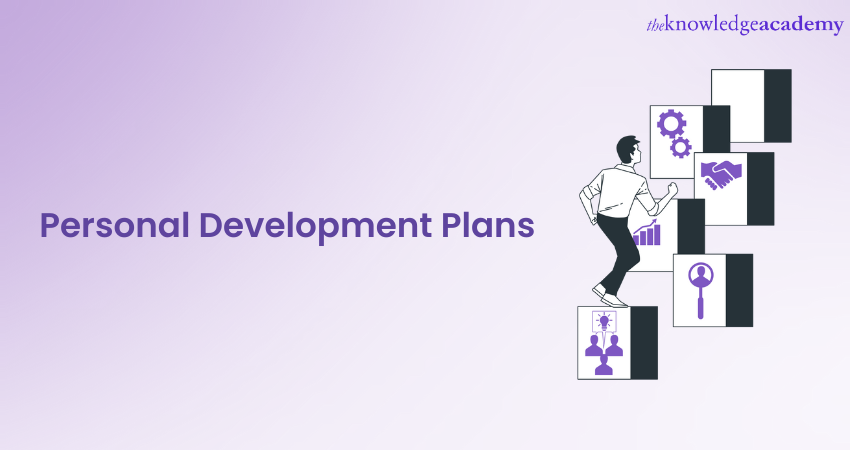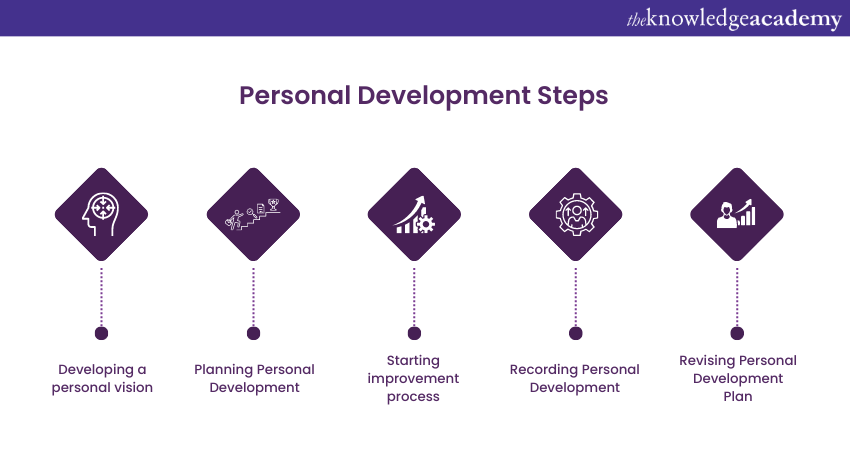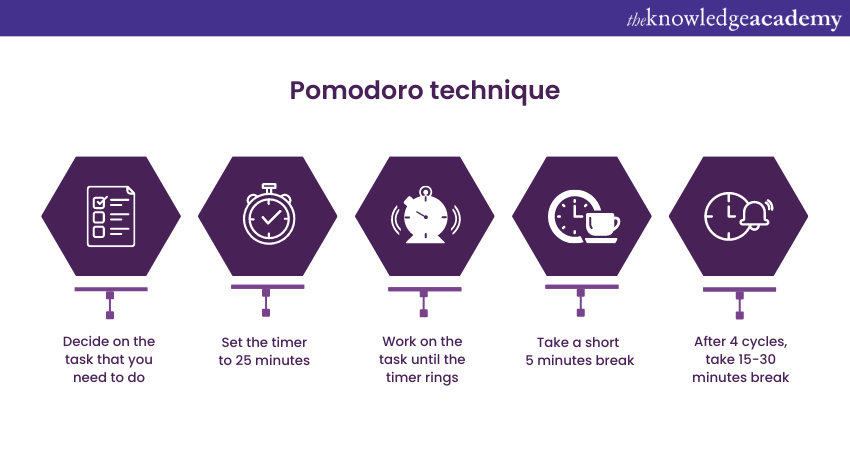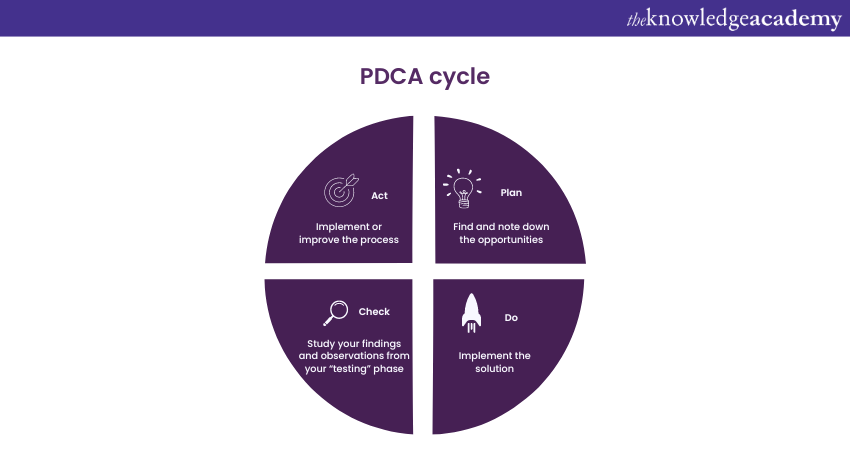We may not have the course you’re looking for. If you enquire or give us a call on + 1-866 272 8822 and speak to our training experts, we may still be able to help with your training requirements.
Training Outcomes Within Your Budget!
We ensure quality, budget-alignment, and timely delivery by our expert instructors.

Do you want to improve yourself in every aspect of your life? Do you have a vision of who you want to be and what you want to achieve? Do you need some guidance and support to make your dreams come true?
If you answered yes to any of these questions, then this blog post is for you. In this post, we will show you how to create, implement, review, and update Personal Development Plans (PDPs) that can help you reach your full potential and live a better life. According to HRnews, 75% of employees in the UK feel that their employer investing in their personal development holds significance.. Craft your successful future with personalised PDPs. Unlock growth and achieve goals with expert guidance. Start your journey today!
Table of Contents
1) What are Personal Development Plans
2) How to create a Personal Development Plan
3) How to implement Personal Development Plan
4) How to review and update a Personal Development Plan
5) Conclusion
What are Personal Development Plans
PDPs are a document that outlines your goals, strategies, resources, and progress in various areas of personal growth, such as skills, knowledge, attitudes, habits, values, and goals. It is a tool that can help you plan, organise, monitor, and evaluate your journey. It can also help you stay motivated, focused, and accountable. Some of the ways it is beneficial are mentioned below:
a) Discover your strengths and weaknesses
b) Identify your opportunities and threats
c) Plan SMART (Specific, Measurable, Achievable, Relevant, and Time-bound) goals
d) Choose the best strategies and resources to achieve your goals
e) Track your progress and results
f) Identify areas for improvement and new opportunities
g) Make necessary adjustments and revisions
h) Celebrate your achievements and milestones
Dive into the world of Personal Development and transform your life with our Personal Development Training. Get ready to elevate your game!
PDPs is a process of improving oneself in various aspects of life. It is way of enhancing one’s potential and achieving one’s aspirations. It can benefit one’s personal and professional life, as weel as one’s health and well-being.

How to create a Personal Development Plan
Creating a PDP is not as hard as it sounds. Infact, it can be fun and rewarding. You can use your creativity and imagination to design a plan that suits your needs and preferences. You can also use your logic and intelligence to make sure your plan is realistic and effective.
Identifying your strengths, weaknesses, opportunities, and threats (SWOT analysis)
This step helps you assess your current situation and potential for growth. You can use a SWOT analysis to list your internal factors (strengths and weaknesses) and external factors (opportunities and threats) that affect your personal development. For example, your strength could be your skills, talents, or achievements; your weaknesses could be your gaps, challenges, or limitations; your opportunities could be your resources, supports, or prospects; and your threats could be your risks, competitors, or obstacles. You can also rate each factor on a scale of 1 to 5 indicate its importance or impact.
A SWOT analysis can help you:
1) Discover your unique selling points and competitive advantages.
2) Identify areas where you need to improve or develop
3) Recognise opportunities where you can grow or excel
4) Anticipate threats that might hinder or harm your progress.
Setting SMART goals
This step helps you define what you want to achieve and how will you measure your success. SMART stands for Specific, Measurable, Achievable, Relevant, and Time-bound. You can use the SMART criteria to set goals that are clear, realistic, and meaningful. For example, instead of saying “I want to learn a new language”, you can “I want to learn Spanish at an intermediate level by the end of the year”. You can also break down your goals into smaller and more manageable sub-goals or milestones.
Choosing the best strategies and resources to achieve your goals
This step helps you plan how you will accomplish your goals and what you will need do so. You can use the following questions to guide you:
1) What actions will you take?
2) What skills will you learn or improve?
3) What resources will you use or access?
4) What support will you seek or offer?
5) How will you overcome potential challenges or barriers?
Revamp your focus skills with finesse. Unlock the secrets of attention management with ours Attention Management Training. Join now!
You can also prioritise your strategies and resources based on their feasibility and effectiveness. For example, you can use online resources, books, podcasts, or apps to learn Spanish; You can join a language exchange group, hire a tutor, or find a mentor to practice Spanish; and you can use flashcards, quizzes, or games to review your Spanish knowledge.
Tracking your progress and results
This step helps you monitor and evaluate your journey. You can use various tools and methods to track your progress and results, such as self-assessment questionnaires, feedback surveys, journals, portfolios, etc. You can also use key performance indicators (KPIs) or metrics to measure your outcomes and achievements, such as test scores, certificates, awards, etc. You can also use charts, graphs, or tables to visualise your data and trends. For example, you can use a language proficiency test to assess your Spanish level; you can use a certificate of completion to validate your online course, and you can use a progress chart to track your learning hours.
How to implement Personal Development Plan
Creating PDP is the first step towards improving yourself and achieving your aspirations. Second step is to implement it. This means putting your plan into action and working towards your goals. Here are some tips on how to implement it effectively:
Schedule time for learning and practicing new skills
One of the most important aspects is learning new things and improving your existing skills. To do this, you need to dedicate some time and effort to your learning activities. You can use a calendar, planner, or app to reschedule you learning sessions and set reminder for yourself. You can also use the Pomodoro technique to break down your learning tasks into manageable chucks and avoid distractions

Seek feedback and support from others:
Another key factor is getting feedback and support from others who can help you improve and grow. You can seek feedback from your mentors, coaches, peers, or managers on your performance and progress. You can also seek for advice, guidance, or tips from experts or role models in your field. You can also join online or offline communities, groups, or networks that share your interests or goals and learn from their experiences and insights.
Overcome challenges and obstacles
As you implement your PDP, you may encounter some challenges and obstacles that might hinder or delay your progress. These could be internal, such as fear, doubt, or procrastination, or external, such as lack of resources, time, or opportunities. To overcome these challenges and obstacles, you need to adopt a positive and resilient mindset that can help you cope with stress and adversity. You can use problem solving techniques to identify the root causes of the issues and find the better solutions for them.
Unleash your inner zen, conquer stress for good. Discover the secrets of stress management with ours Stress Management Training. Join now!
Celebrate achievement and milestones.
Finally, as you implement your PDP, you should also celebrate your achievements and milestones along the way. This can help you boost you motivation, confidence, and self-esteem. You can also use these achievements and milestones as the opportunities to review and update your PDPS and set new goals for yourself. You can celebrate your achievements and milestones by rewarding yourself with something you enjoy, such as treat, a gift, or a break. You can share your success stories with others who support you and appreciate you.
How to review and update a Personal Development Plan
Third step is reviewing and updating a PDP helps you in keeping track of your personal growth and development. It helps you measure your performance and achievements in relation to you goals and strategies. It also can help you improve and optimise it based on you evaluation results. To review and update your PDPs, you need to do two main steps:
Evaluating your personality development periodically
This means measuring how well you are doing in achieving your goals and following your strategies. You can use different tools and methods to evaluate your personality development periodically, such as
a) Self-assessment questionnaires
These are questions that you ask yourself to reflect on your Personal Development. For example, you can ask yourself;
1) How satisfied am I with my progress?
2) What have I learned from my experience?
3) What are the challenges that I faced?
4) How did I overcome them?
5) You can scale your answers from 1 to 10 to rate your answers.
b) Feedback surveys
These are question that you ask others to give you feedback on your Personal Development. For examples, you can ask your mentors, coaches, peers, or managers;
1) How do you think I am doing in achieving my goals?
2) What are the strength and weakness of my PDP?
3) How can I improve my Personal Development skills?
You can use a scale of 1 to 5 to rate their answers.
You can also use Key Performance Indicators (KPIs) or metrics to measure your outcomes and achievements, such as test score, certificates, awards, etc. You can also use chart, graphs, or tables to visualise your data and trends. For example, you can use a language proficiency test to assess your Spanish level; you can use a certification of completion to validate you online course; and you can use a progress chart to track your learning hours.
Updating Personal Development Plan
Last step in this process is updating PDP. This mean changing or updating your goals, strategies, resources, or progress based on your evaluation results. Updating it is a process that helps you improve and optimise your plan. You can use different tools and methods to adjust and revisions, such as:
PDCA cycle

This a four-step method that helps you continuously improve your PDP by planning what to do, doing it, checking the results, and acting in the feedback. The steps are:
a) Plan
This is where you set or revise your goals, strategies, resources, or progress based on you evaluation results. For examples, you can change your goal from learning Spanish at an intermediate level by the end of the year to learning Spanish at an advance level by the end of the year.
b) Do
This is where you implement or execute your plan by following your strategies and using your resources. For example, you can enrol in an online course that teaches Spanish at an advance level.
c) Check
This is where you monitor or measure your performance and achievements by using the tools and methods mentioned above. For example, you can take a language proficiency test to test your Spanish level.
d) Act
This is where you act on the feedback or results by making further adjustments or revisions to your plan if needed. For example, you can modify your strategy from enrolling in an online course to hiring a tutor if you need more personalise options.
e) Smart criteria
These are criteria that help you det or revise goals that are clear, realistic, and meaningful. SMART stands for Specific, Measurable, Achievable, Relevant, and Time-bound. You can use SMART criteria to check if your goals are well-defined and attainable.
Conclusion
A PDP is a powerful tool to help you achieve your goals and aspirations. It helps you identify your strengths, weaknesses, opportunities, and threats, and create a roadmap for your growth and success. PDP is not a one-time thing, but a continuous process that requires regular review and adjustment. So, keep learning, keep growing, and keep achieving.
Frequently Asked Questions
Upcoming Business Skills Resources Batches & Dates
Date
 Time Management Training
Time Management Training
Fri 10th Jan 2025
Fri 14th Feb 2025
Fri 11th Apr 2025
Fri 13th Jun 2025
Fri 8th Aug 2025
Fri 26th Sep 2025
Fri 21st Nov 2025







 Top Rated Course
Top Rated Course



 If you wish to make any changes to your course, please
If you wish to make any changes to your course, please


